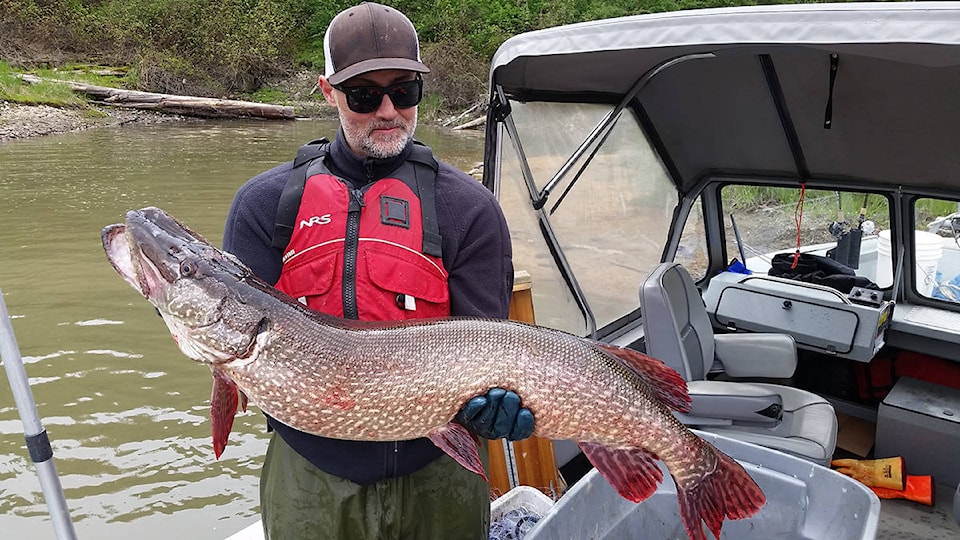Northern pike suppression continued on the Columbia River this fall with the final results showing less is indeed more when it comes to the predatory invasive species.
“The catch rates have probably levelled off in the last few years,” said Matt Neufeld, Kootenay fish biologist for BC Ministry of Forest, Lands, Natural Resources (FLNRO). “Because they’re super low.”
The Columbia Basin Trust, BC Hydro, and FLNRO joined forces to fund this year’s program and secured the services of Mountain Water Research and Wood Environmental to conduct a four-day survey in August and another in September and October with a combination of gill netting and boat electro-fishing in efforts to reduce the pike population in the Columbia.
Wood Environmental’s Aquatic Biologist, Crystal Lawrence, confirmed that a total of 27 northern pike, seven females and 20 males, were removed from the Columbia River in 2018.
Twenty-two were removed during 525.3 hours of gill-netting and five during just over five hours of boat electrofishing surveys. As in previous years, most of the suppression effort occurred in May when northern pike are preparing to spawn, explained Lawrence.
“Gill-nets are set in areas with typical pike spawning habitat; shallow, slow water areas with instream cover provided by vegetation and woody debris.”
The spring surveys focused on where the majority of pike were captured in the past, largely in areas with the most suitable pike habitat, ie: the Robson Reach, which includes the area between Hugh Keenlyside Dam and Castlegar, Kootenay River Oxbow, Waldies Island, and Zuckerberg Island.
“We also spent two days in the late summer sampling near Genelle and upstream of Trail in bays with suitable pike habitat but none were captured or observed.”
A prime concern for most anglers on the Columbia is whether northern pike are spawning successfully. Northern pike are apex predators, voracious and adaptable, and can severely impact an aquatic ecosystem in a relatively short period of time.
“Though we didn’t catch any juveniles this year, we do believe pike are recruiting, at least intermittently, in the Robson Reach,” said Lawrence. “Jeremy (Baxter of Mountain Water Research) captured young of the year near Castlegar last year and the ONA (Okanagan Nation Alliance) captured one young of the year near Robson in 2016.”
Pike were first identified in the Columbia River in 2009, but fisheries management caught more than 130 in the first year of pike suppression in 2014, with the number declining every year since.
“It doesn’t look like the spawning success is very high because after the initial removal the first couple years, our catch rates are quite low,” said Neufeld.
In stark contrast, the pike population south of the border in Lake Roosevelt, a reservoir of the Columbia River, is growing.
Fisheries managers estimate that upwards of 10,000 northern pike have moved into the massive reservoir, and that ultimately, they could decimate the trout population.
“Well, I think over time northern pike in Lake Roosevelt will wipe out all the trout,” Chris Donley, the Washington Department of Fish and Wildlife’s Eastern Region fish program manager, told the Spokesman Review. “That’s how serious a problem it is.”
What’s more, if the fish make it farther down the Columbia River system, they could decimate an already struggling salmon population.
“They’ve demonstrated that they can collapse a salmon fishery in a manner of a couple decades,” said Nick Bean, fisheries conservation program manager for the Kalispel Tribe.
The southern BC section of the Columbia is one of the last free-flowing sections of the river and may prove a deterrent to pike recruitment.
“It’s not a surprise to me that they’ve established in Lake Roosevelt,” added Neufeld. “They certainly have better habitat there, they’ve got more of that weedy, shallow, warm habitat they like but they also require it for spawning. The Columbia is not really ideal spawning habitat.”
BC fisheries instituted a pike-reward program for the Columbia River, Arrow and Pend d’Oreille Reservoirs earlier this year. Run by ONA and Central Kootenay Invasive Species Society, a bounty of $10 will be paid for each pike caught, and the head dropped off at any of the following collection stations: Johnny’s Grocery and Gas, Castlegar, Golder Associates, Castlegar, Regional District Kootenay Boundary Office, Trail, and Christina Lake Stewardship Society, Christina Lake.
“The (pike suppression) program was not intended to confirm if the pike are recruiting,” added Lawrence. “But the study supplied sample tissues to researchers in Washington State who are using otolith microchemistry to see if they can determine where the pike were recruited.”
